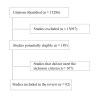Adaptability of Assistive Mobility Devices and the Role of the Internet of Medical Things: Comprehensive Review
- PMID: 34779786
- PMCID: PMC8663709
- DOI: 10.2196/29610
Adaptability of Assistive Mobility Devices and the Role of the Internet of Medical Things: Comprehensive Review
Abstract
Background: With the projected upsurge in the percentage of people with some form of disability, there has been a significant increase in the need for assistive mobility devices. However, for mobility aids to be effective, such devices should be adapted to the user's needs. This can be achieved by improving the confidence of the acquired information (interaction between the user, the environment, and the device) following design specifications. Therefore, there is a need for literature review on the adaptability of assistive mobility devices.
Objective: In this study, we aim to review the adaptability of assistive mobility devices and the role of the internet of medical things in terms of the acquired information for assistive mobility devices. We review internet-enabled assistive mobility technologies and non-internet of things (IoT) assistive mobility devices. These technologies will provide awareness of the status of adaptive mobility technology and serve as a source and reference regarding information to health care professionals and researchers.
Methods: We performed a literature review search on the following databases of academic references and journals: Google Scholar, ScienceDirect, Institute of Electrical and Electronics Engineers, Springer, and websites of assistive mobility and foundations presenting studies on assistive mobility found through a generic Google search (including the World Health Organization website). The following keywords were used: assistive mobility OR assistive robots, assistive mobility devices, internet-enabled assistive mobility technologies, IoT Framework OR IoT Architecture AND for Healthcare, assisted navigation OR autonomous navigation, mobility AND aids OR devices, adaptability of assistive technology, adaptive mobility devices, pattern recognition, autonomous navigational systems, human-robot interfaces, motor rehabilitation devices, perception, and ambient assisted living.
Results: We identified 13,286 results (excluding titles that were not relevant to this study). Then, through a narrative review, we selected 189 potential studies (189/13,286, 1.42%) from the existing literature on the adaptability of assistive mobility devices and IoT frameworks for assistive mobility and conducted a critical analysis. Of the 189 potential studies, 82 (43.4%) were selected for analysis after meeting the inclusion criteria. On the basis of the type of technologies presented in the reviewed articles, we proposed a categorization of the adaptability of smart assistive mobility devices in terms of their interaction with the user (user system interface), perception techniques, and communication and sensing frameworks.
Conclusions: We discussed notable limitations of the reviewed literature studies. The findings revealed that an improvement in the adaptation of assistive mobility systems would require a reduction in training time and avoidance of cognitive overload. Furthermore, sensor fusion and classification accuracy are critical for achieving real-world testing requirements. Finally, the trade-off between cost and performance should be considered in the commercialization of these devices.
Keywords: adaptability; assistive mobility devices; internet of medical things framework; internet of things; mobile phone; mobility aids; multisensor fusion; user system interface.
©Daniel Ayo Oladele, Elisha Didam Markus, Adnan M Abu-Mahfouz. Originally published in JMIR Rehabilitation and Assistive Technology (https://rehab.jmir.org), 15.11.2021.
Conflict of interest statement
Conflicts of Interest: None declared.
Figures
References
-
- Ud Din I, Guizani M, Hassan S, Kim B, Khan MK, Atiquzzaman M, Ahmed SH. The internet of things: a review of enabled technologies and future challenges. IEEE Access. 2019;7:7606–40. doi: 10.1109/ACCESS.2018.2886601. http://paperpile.com/b/OPBx0q/Pl7h - DOI
-
- Fan T, Chen Y. A scheme of data management in the internet of things. Proceedings of the 2nd IEEE International Conference on Network Infrastructure and Digital Content; 2nd IEEE InternationalConference on Network Infrastructure and Digital Content; Sept. 24-26, 2010; Beijing, China. 2010. pp. 110–4. - DOI
-
- Riazul Islam SM, Kwak D, Kabir MH, Hossain M, Kwak KS. The internet of things for health care: a comprehensive survey. IEEE Access. 2015;3:678–708. doi: 10.1109/ACCESS.2015.2437951. - DOI
-
- Al-Fuqaha A, Guizani M, Mohammadi M, Aledhari M, Ayyash M. Internet of things: a survey on enabling technologies, protocols, and applications. IEEE Commun Surv Tutorials. 2015;17(4):2347–76. doi: 10.1109/comst.2015.2444095. - DOI
-
- Pang Z. Thesis and Dissertations - Royal Institute of Technology. Stockholm, Sweden: KTH - Royal Institute of Technology; 2013. Technologies and architectures of the internet-of-things ( IoT ) for health and well-being.
Publication types
LinkOut - more resources
Full Text Sources



